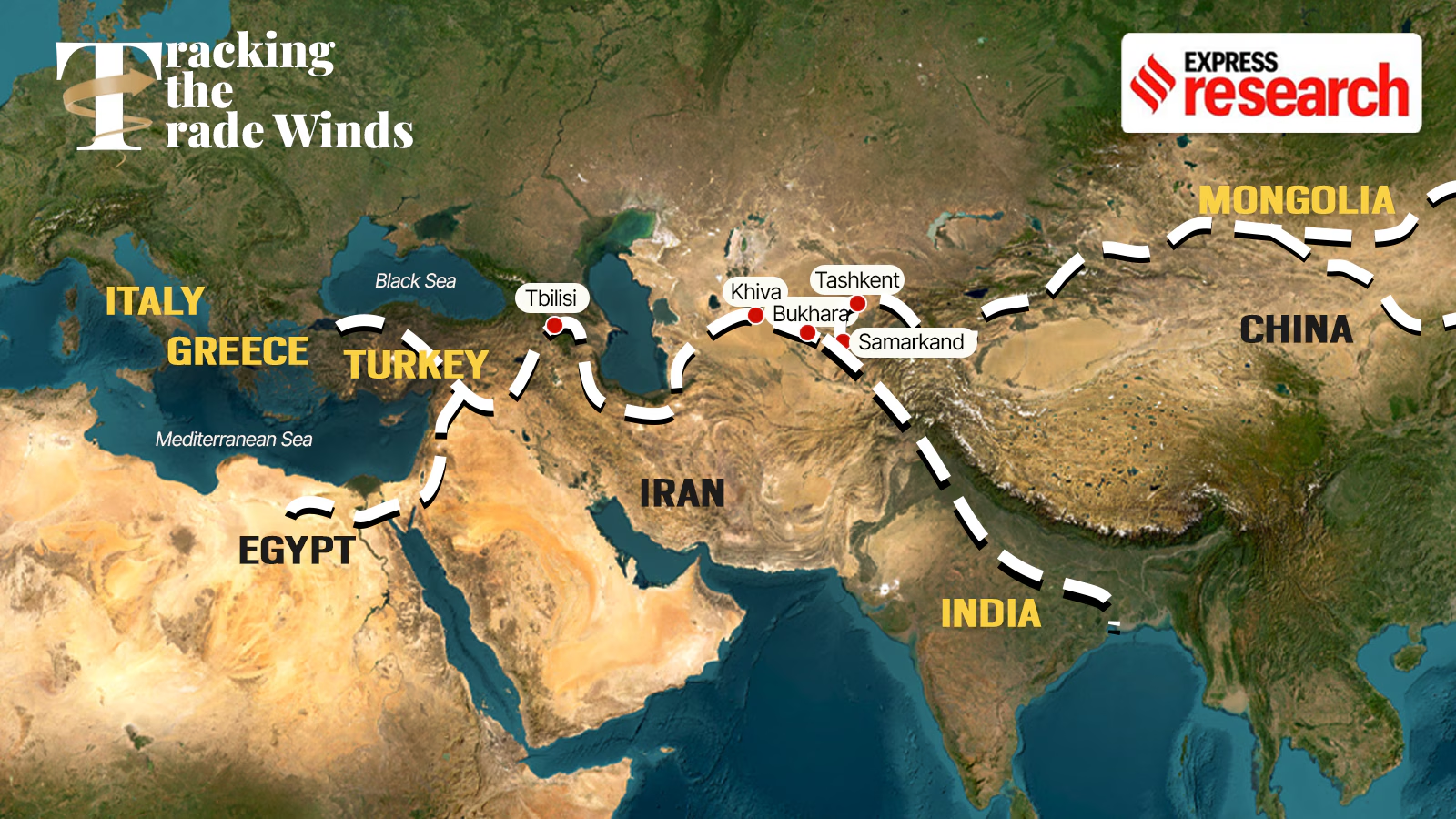
The Role of the Silk Road in Connecting East and West
Introduction: A Tapestry of Trade and Culture
The Silk Road, a term coined by the German geographer Ferdinand von Richthofen in 1877, evokes images of camel caravans traversing vast deserts, bustling marketplaces overflowing with exotic goods, and the slow but steady exchange of ideas and cultures across continents. More than just a single road, it was a complex network of interconnected land and sea routes stretching over 4,000 miles (6,400 km), from the bustling eastern coast of China to the vibrant Mediterranean world. For centuries, this intricate web served as a vital artery for international trade, cultural exchange, and diplomatic relations, profoundly shaping the destinies of civilizations across Eurasia. This exploration delves into the multifaceted history of the Silk Road, examining its origins, its golden age, its eventual decline, its enduring legacy, and its surprising resurgence in the modern world. We will explore its impact on economics, culture, religion, technology, and the very fabric of societies it connected.
The Genesis of Exchange: Early Development and the Han Dynasty
The seeds of the Silk Road were sown during the Han Dynasty (206 BCE – 220 CE), a period of remarkable expansion and consolidation in China. Ambitious emperors, driven by a desire to expand their empire’s influence and access new markets, dispatched diplomatic missions deep into Central Asia and the Middle East. These missions weren’t solely diplomatic; they were also crucial for establishing trade relationships. The allure of Chinese goods – the exquisitely woven silks that lent the route its name, delicate porcelain, and the invigorating tea – proved irresistible to the people of Central Asia and beyond. In return, China received horses, valuable spices, and other exotic goods that enriched its economy and culture.
These early exchanges, however, were not without their challenges. The journey was fraught with dangers: bandits, harsh weather conditions, and the ever-present threat of conflict between rival empires. But the potential rewards were immense, driving individuals and governments to overcome these obstacles. The establishment of safe havens – oases providing rest, supplies, and protection – along the route became essential, fostering the growth of settlements and towns that would eventually flourish as important trading centers. The early Silk Road was not a smoothly paved highway but a network of trails, adapting to the landscape and the needs of travelers.
Beyond Merchandise: The Transmission of Ideas and Faith
The Silk Road’s significance transcends mere economic exchange. It served as a powerful conduit for the transmission of ideas, philosophies, and religions, fundamentally shaping the cultural landscape of Eurasia. Buddhism, originating in India, found a fertile ground in China and other parts of East Asia, largely thanks to the Silk Road. Buddhist monks, scholars, and pilgrims journeyed along the routes, spreading their teachings and establishing monasteries that became centers of learning and spiritual practice. The exchange wasn’t one-way; Chinese philosophies and artistic styles also found their way westward, enriching the cultural fabric of the regions they encountered.
Similarly, the spread of Christianity and Islam along the Silk Road significantly altered the religious landscape. Nestorian Christianity, a branch of Christianity, made significant inroads into Central Asia and China, leaving behind architectural marvels and artistic expressions that testify to its influence. The expansion of Islam, following the rise of the Prophet Muhammad in the 7th century, had a profound impact, shaping the cultural identity of vast stretches of land along the routes. Muslim traders and scholars carried their faith eastward, establishing thriving communities and mosques that became centers of learning and commerce.
The Tang Dynasty: A Golden Age of Interconnection
The Tang Dynasty (618-907 CE) witnessed the Silk Road’s zenith, a period often referred to as its “golden age.” China, under the Tang emperors, experienced a period of unprecedented prosperity and cultural flourishing. This economic strength fueled the expansion and intensification of trade along the Silk Road. The city of Chang’an (modern-day Xi’an), the Tang capital, became a cosmopolitan hub, attracting merchants, scholars, and artists from across the globe. The city’s bustling markets showcased a dazzling array of goods from across Eurasia, testament to the extensive reach of the Silk Road network.
The Tang Dynasty’s open policy towards foreign interactions fostered a climate of intellectual and cultural exchange. Scholars from across the Silk Road network engaged in intellectual discourse, contributing to the advancements in various fields. The exchange of scientific knowledge, technological innovations, and artistic styles enriched the cultures of the East and West, blurring the lines between them. The Tang Dynasty’s embrace of cosmopolitanism significantly contributed to the Silk Road’s success and its lasting impact on the global cultural landscape.
Technological Transfer and Innovation Along the Silk Road
The Silk Road wasn’t just a pathway for goods and ideas; it also facilitated the transfer of crucial technologies. The invention of gunpowder in China, for instance, eventually found its way westward, revolutionizing warfare and having long-lasting impacts on military strategies and societal development. Papermaking, printing, and other significant technologies also spread along the routes, shaping the development of communication, governance, and commerce in the regions they reached. The cross-fertilization of technological innovations spurred further advancements, demonstrating the power of global exchange in driving progress.
The spread of agricultural techniques and crops also had a dramatic impact. New crops were introduced, improving diets and agricultural practices in various regions. The exchange of agricultural knowledge transformed agricultural systems, improving food production and contributing to population growth in many regions connected by the Silk Road.
The Shadow of Decline: Factors Contributing to the Silk Road’s Waning Influence
The Silk Road’s dominance gradually waned from the 14th century onwards, a decline attributable to a confluence of factors. The devastating Black Death, which swept across Eurasia in the mid-14th century, decimated populations and disrupted trade networks. The rise of the Mongol Empire, while initially opening new routes, eventually led to instability and insecurity along certain sections of the Silk Road. Perhaps most significantly, the rise of maritime trade routes offered a faster, more efficient, and less hazardous alternative for long-distance commerce. European exploration and the establishment of sea routes to Asia shifted global trade patterns, diminishing the relative importance of the land-based Silk Road.
However, it’s crucial to emphasize that the Silk Road didn’t simply vanish overnight. Trade along some routes continued, albeit on a smaller scale. The legacy of the Silk Road remained deeply embedded in the cultural and economic fabric of the regions it had once connected, its influence persisting for centuries after its decline.
The Enduring Legacy: Shaping Modern Societies
The legacy of the Silk Road is profound and multifaceted. It fundamentally altered the course of history, shaping the cultural, religious, and economic landscapes of Eurasia. The enduring influence of Buddhism in East Asia, the presence of Islamic traditions in Central Asia, and the exchange of artistic styles across continents are all lasting testaments to the Silk Road’s impact. The diverse cultures and ethnicities that emerged along the route stand as a testament to the lasting effects of cultural cross-fertilization.
The economic impact was equally significant. The Silk Road fostered the growth of cities, stimulated economic development, and promoted the exchange of goods and services. The development of international trade, facilitated by the Silk Road, laid the foundation for the globalized economy we see today. The establishment of trade routes and protocols for cross-continental commerce provided a framework for future international trade relations.
The Belt and Road Initiative: A Modern Revival?
In recent years, China’s Belt and Road Initiative (BRI) has sparked a renewed interest in the Silk Road’s historical significance and potential for economic cooperation. The BRI aims to revive the spirit of connectivity and collaboration by developing infrastructure – roads, railways, ports, and digital networks – across Eurasia and beyond. While the BRI shares some similarities with the historical Silk Road, it operates in a vastly different geopolitical landscape and faces different challenges and opportunities.
The BRI’s ambition is vast, encompassing infrastructure projects, trade agreements, and diplomatic initiatives across a broad swathe of countries. It aims to boost economic growth and development in participating countries, promoting trade and connectivity. While the initiative has generated significant excitement and investment, it has also faced criticism concerning environmental impact, debt sustainability, and potential geopolitical implications.
The Challenges and Opportunities of a Renewed Silk Road
The revival of the Silk Road concept, embodied by the BRI and other initiatives, presents both immense opportunities and significant challenges. The potential for economic growth and development in participating countries is undeniable. However, concerns about environmental sustainability, debt burdens, and potential for geopolitical tensions necessitate careful consideration. The balance between economic development and social equity, environmental protection, and political stability will be crucial for the success of any modern Silk Road initiative.
The cultural exchange aspect is also complex. While the Silk Road historically facilitated cultural exchange, concerns about cultural homogenization and the dominance of certain cultures over others are valid. The need to promote cultural diversity and respect for local traditions must be prioritized.
Conclusion: A Legacy of Exchange and Interconnection
The Silk Road, in its historical and modern interpretations, stands as a powerful symbol of intercultural exchange, economic cooperation, and the enduring human desire for connection. Its historical legacy is profoundly woven into the fabric of numerous civilizations, shaping their cultures, religions, and economies. Its modern revivals, while facing their own unique set of challenges, demonstrate the enduring allure of connectivity and the potential for collaboration across vast geographical and cultural divides. Understanding the Silk Road’s rich history is crucial for navigating the complexities of a globalized world and for fostering a future where cooperation and mutual understanding triumph over conflict and isolation. The story of the Silk Road is not simply one of trade; it’s a testament to the enduring power of human interaction and its transformative impact on the world.


